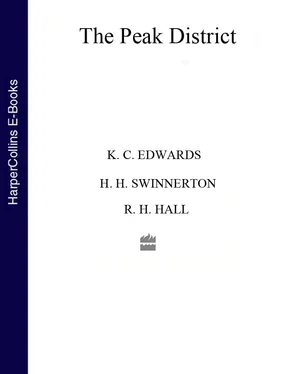1 ...6 7 8 10 11 12 ...15 Thus it came to pass that the arrangement of streams laid down upon the surface of the chalk was eventually incised into the underlying Carboniferous rocks. These, however, had been folded long ago and the layers had been tilted at varying angles in differing directions. Henceforth the streams flowed on regardless of the directions in which the rocks dipped or of the way in which they were folded. Such a drainage system is said to be superimposed . One outcome of this is that the scenery along the valleys is more varied than alongside normal streams. Thus, for example, in the main valley of the area, that of the Derwent, grit scars, limestone gorges and wide fertile dales alternate with one another.
THE ICE AGE
One last event remains to be mentioned. The period popularly known as the Great Ice Age was on the whole a time of mild and even warm climate, interrupted now and then by polar conditions when icefields formed over the mountainous regions and, flowing thence, covered the lowlands and filled up the adjoining sea basins. During one of the earliest of these interruptions, or glaciations, all but the extreme south of England was covered with ice. Nevertheless the presence on the South Pennine moorlands of rocking stones and other stones fantastically shaped by prolonged weathering in pre-glacial times indicates that some of the highest parts of the Peak District were never subjected to the scouring action of overflowing ice.
During a later glaciation ice from the Irish Sea invaded the lowlands of Lancashire and Cheshire and, impinging against the flanks of the West Moors, attained an altitude of 1,250 feet. At that time a trickle of ice finding its way across a gap at the Dove Holes, northwest of Buxton, entered the tributary valleys of the Derwent and even reached the vicinity of Matlock. This ice did not, however, leave any appreciable impression upon the scenery of the district. Nevertheless, whenever such arctic conditions prevailed they intensified the action of more normal agents. The snow which accumulated in the winter melted in the early summer. On the shale areas the ground became sodden in the daytime and frozen at night with the result that soil creeping and land sliding took place on a massive scale and greatly accentuated the concavities of the valley slopes.
Elsewhere in England and north-west Europe, Old Stone Age Man appeared upon the scene and gained a livelihood by hunting. Outside the Peak District, though quite near, the caves at Creswell have yielded a very full and unique record of his sojourn in this part of England. In striking contrast is the solitary discovery of one flint implement referable to that time within The Peak in the vicinity of Wirksworth. It is sufficient, however, to indicate that Palaeolithic Man was an occasional visitor. As will be seen later, evidence for the presence of prehistoric man is much more abundant in post-glacial times.
REFERENCES
MARSHALL, C. E. Guide to the Geology of the East Midlands . University of Nottingham (1948)
Memoirs of the Geological Survey
WRAY, D. A., EDWARDS, W., and TROTTER, F. M. The Pennines and Adjacent Areas . Third edition. British Regional Geology. H.M.S.O. (1954)
WATERS, R. S. and JOHNSON, R. H. The Terraces of the Derbyshire Derwent. East Midland Geographer: 9 (June, 1958)
CHAPTER 3
THE MAKING OF THE SCENERY
Approach we then this classic ground:
More gentle name was never found
By chance, nor more of picturing sound
To tell the spirit of the scene .
EDMUND BLUNDEN: Dovedale
THE SCENERY of the Peak District is a treasury of features, some new, some old. Relics of the far-distant past are closely linked with others of more recent origin; some beautiful, others rugged, weird, mystifying. It is the outcome of a long process of sculpturing which was produced by slow incessant change. Throughout all these ages, however, the rocks have remained unchanged in quality and arrangement and have exerted a constant though passive influence upon the landscape. A brief consideration of the nature of that influence will provide a useful background against which to watch the development of the scenery as it exists today.
There are three main types of rocks in the district—limestone, grit and shale. Volcanic tuffs and intrusive dolerite play a minor but interesting part.
ROCKS AND SCENERY
Limestone is a hard, almost impervious stone. Consequently very little rain-water penetrates into its substance. This fact shields it from the shattering action of frost. On the other hand, it is slightly soluble in natural water. Just as a cube of sugar becomes rounded as it dissolves in tea, so the contours of the limestone surface tend to develop smooth curving outlines.
Even the purest limestone contains small quantities of dust and other earthy materials. This is left behind on the surface of the rock and accumulates to form soil. On slopes the soil is usually too shallow to give firm foothold for trees, except for the ash, but it is covered by a carpet of grass and flowers which provides valuable pasturage. The more level ground on the platforms and along valley bottoms has a covering of much deeper soil. Here trees and bushes may flourish except where the altitude is such as to expose them to the influences of strong winds.
The debris shed by the vegetation becomes mixed with the soil. There it rots and produces weak humic acids which are taken into the water percolating down through the soil and thus intensify its solvent action upon the limestone.
Limestone, like other rocks, is arranged in layers or strata, each of which is broken into more or less cubical blocks by the presence of two sets of cracks known as joints and bedding planes. Descending water finds its way down even the finest of the joints and along the closest bedding planes, and by dissolving the stone on either side widens these into open fissures. Eventually these become so spacious that most of the rain-water abandons the streams upon the surface and flows away along these newly formed underground channels. Below a certain depth all cracks and fissures are permanently filled with water. That depth is spoken of as the water-table and thus becomes the surface along which these underground streams flow.
Sometimes a surface valley is deep enough for its floor to lie along or even slightly below the water-table. In these circumstances a surface stream or river is maintained which is remarkably constant in its flow and rarely swells into flood in wet seasons or shrinks and disappears in times of drought. The Dove is a good example of this type of river.
Grit, on the other hand, is practically insoluble in water. It is, however, so porous that rain-water is quickly absorbed and, soaking inwards away from the surface, leaves this dry. The water, however, fills all the pores and cracks in the deeper layer, which then become saturated. The dry superficial parts of the grit are consequently less liable to destruction by frost action and therefore retain their angular forms and sharp edges. Some grits contain grains of felspar, a mineral which is gradually rotted by natural water. In these cases the rock disintegrates more rapidly.
Shale is more finely porous than grit. Water therefore percolates into it more slowly and is retained in its surface films. There its prolonged presence softens the rock and favours the pulverising action of frost. In areas where shale is the dominant rock, vertical erosion by streams and valley-widening proceed more rapidly. In these areas landslips occur on the steeper slopes and under the overwhelming pressure of superincumbent rocks the shaley sides of the valleys may even begin to bulge. Examples of such features may be seen around Edale and other vales.
Читать дальше












